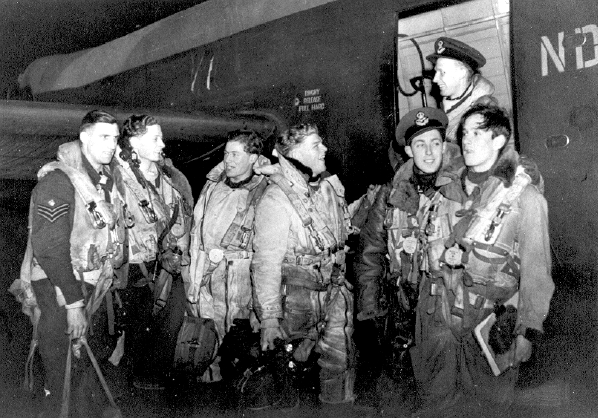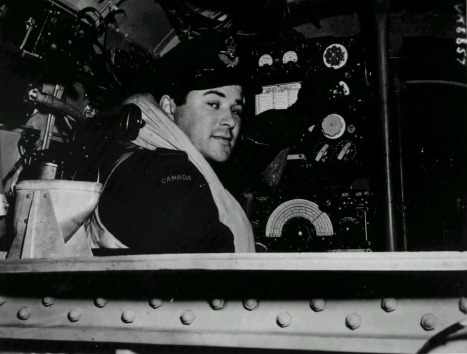 Bomber Command
Bomber Command  |
Aircrew Chronicles
|
Aircrew Losses
|
Nose Art
|
BCATP
|
Lancaster
|
Media
|
Aircrew Chronicles
|
Aircrew Losses
|
Nose Art
|
BCATP
|
Lancaster
|
Media
 Bomber Command
Bomber Command  |
Aircrew Chronicles
|
Aircrew Losses
|
Nose Art
|
BCATP
|
Lancaster
|
Media
|
Aircrew Chronicles
|
Aircrew Losses
|
Nose Art
|
BCATP
|
Lancaster
|
Media
The Lancaster Bomber

A Lancaster crew numbered seven - the pilot, flight engineer, navigator, wireless (radio) operator, bomb aimer/ front gunner, mid-upper gunner, and rear gunner. Invariably all were very young, a man of twenty-five would likely be referred to as the "Old Man" or "Grandpa." They were of different ranks, came from all walks of life, and often from more that one country. However, they quickly bonded together to form a very special, tightly-knit group. This camaraderie was crucial to maintaining morale and efficiency in the air. Most felt that their crew was one of the best in Bomber Command. They generally spent many of their off-duty hours together as well as the first day or two of a leave.

|
The bomb-aimer's compartment was situated in the front of the aircraft at a level below that of the main cockpit. Lying on his stomach and looking through the bombsight out the large perspex blister, the bomb-aimer would guide the aircraft to the target and release the bomb load. As well, the bomb-aimer was responsible for operating the front gun turret positioned directly above him, although this was not necessary on most operations. Regardless of rank, the pilot was always in command of the aircraft. Behind his head was the only piece of armour plating that a Lancaster carried.
|
Seated beside the pilot on a seat which was hinged to permit crew to travel to and from the bomb-aimer's compartment in the nose of the aircraft was the flight engineer. He assisted the pilot on take-off and landings by handling the throttles. In flight he was constantly checking his panels to monitor oil, fuel and pressure gauges to assess engine performance and fuel consumption from the Lancaster's six wing tanks. Although flight engineers were generally trained to fly the aircraft "straight and level" they had no formal pilot training and hoped that they would never have to try to land the aircraft.
Behind the pilot and flight engineer, the navigator worked in a curtained off compartment so that the lights he required would not give away the position of the Lancaster to enemy fighters. Few navigators had the time, or the inclination, to leave their station during a raid. They were constantly plotting the aircraft's course and making adjustments for wind and other factors. As electronic navigational aids developed during the war the navigator's work load became even greater.
The wireless operator's station was just in front of the main spar, in the rear part of the cockpit section. In addition to his official duties related to the radio equipment, the W/Op was also expected to have a working knowledge of the navigator's equipment, understand the aircraft's electrical and intercom systems, and administer first aid as necessary. As well, he was generally on duty in the astrodome in the event of contact with enemy fighters and over the target. The astrodome was a dome shaped piece of perspex which protruded above the aircraft's fuselage in order that the navigator could take star shots. As well it provided an excellent viewpoint.
The mid-upper gunner and rear-gunner completed the crew. Both were extremely vulnerable and in the coldest part of the aircraft. Their duties were to continuously scan the night sky for enemy fighters from the moment of take off until the aircraft landed, sometimes ten hours later. Their most important contribution was to spot the fighter and instruct the pilot to take evasive action. When this occurred the fighter generally broke off the contact and looked for another bomber with a less alert air gunner.
Of the 2500 personnel which were housed on a wartime Bomber Command airfield, only ten percent were aircrew. Dozens of others were required to prepare each Lancaster for flight and the ground crew were most appreciated by the aircrew. Generally working outside, the conditions especially in the winter were often windswept, wet and cold. Their contributions to the successes of the effort cannot be overemphasized. The ground crew which were associated with each aircraft took immense pride in "their" aircraft and would joke that they were only "loaning" the bomber for a few hours and that the aircrew were "not to break it."